The Convention on the International Regulations for Preventing Collisions at Sea, 1972 (COLREGs) cover the rules of navigation and lights and shapes that sailors need in order to avoid collision. However, this is a long document and you’ve got to read the whole thing and all the annexes, and then read the Coast Guard’s interpretation of these rules to truly understand what is expected of a sailor. Based on a number of questions from readers and our own observations, the editors at Practical Sailor recognized that as technology and watercraft have evolved, a few navigation rules pertaining to recreational boats could use further clarification. There are situations that the COLREGs do not describe well, and some rules that are so commonly misunderstood that they bear repeating. For the purposes of this article, rules cited are from the United States Coast Guard Navigation Rules International-Inland (publication COMDTINST M16672.2D). The rules referenced here are the international rules, and inland sailors should familiarize themselves with any inland variations, of which there are several.


THE FUNDAMENTALS
In this report we’ll look at how we can resolve common right-of-way issues, particularly when more than one rule in the COLREGs apply. The main challenge in any right-of-way situation is determining which vessel is the privileged (stand-on) vessel, and which vessel is the burdened (give-way) vessel and therefore required to take any needed action. We’ll focus here on the rules that seem to create the most confusion.
Rule 2 | Responsibility. You are always responsible to do everything practical to minimize risk, especially to avoid a collision. It is never 100-percent the other guy’s fault.
Rule 5 | Look-out. You must maintain a look-out using multiple means, and you must apprise the risk of collision of all vessels as they become known to you. Nothing should be a surprise; you should always have the option to take action as early as possible.
Rule 6 | Safe Speed. Consider the conditions, including visibility, traffic, maneuverability, weather, and water depth. You must always have time and space to perform any necessary actions.
Rule 9 | Narrow Channels. This rule takes precedence over crossing rules and the vessel hierarchy described in Rule 18 (sail vs. power vs. fishing boat, etc.). Smaller vessels (sailboats too) should keep to the outside of ship channels and keep as far as practical to starboard.
Rule 13 | Overtaking. The passing vessel must give way to everything–unless it is a vessel that is not under command (NUC), which by definition is unable to maneuver. Overtaking includes crossing 22.5 degrees aft of the beam, not just from dead astern. Note that sailboat racing rules are a little different, but the COLREGs apply to all meetings between boats not engaged in a race.
Rule 14 | Head-on. When two power-driven vessels are meeting on reciprocal courses or nearly reciprocal courses, each shall alter course to starboard so they pass on the port side of each other. This is easier in the daylight, obviously, but at night familiarity with navigation lights takes on obvious importance.
Rule 15 | Crossing. In crossing situations under power, the vessel to starboard has right of way.
Rule 18 | Responsibilities Between Vessels. Only after the requirements of Rules 9 and 13 are satisfied do you consider the hierarchy of a burdened vessel as described above (not under command or NUC, restricted in her ability to maneuver or RAM, then fishing, sail, power, seaplane). Key point: A sailing vessel equipped with an auxiliary engine that is under power has the same burden of responsibility as a powerboat. The term “power-driven vessel” means any vessel powered by machinery. That includes a sailboat with sails hoisted with the engine running.
Rule 20 | Displaying shapes and lights. You must display the day shape or lights appropriate to your status (sail, power, engaged in fishing, restricted ability to maneuver, etc.) and you only have the status you display. However, Rule 2 and Rule 5 say you are responsible for observing the world around you. If a lobster boat appears to be hauling traps, we should treat it as if it were engaged in fishing.
There is a temptation to always give way, but the COLREGs are not about politeness. The rules are meant to promote maneuvering in a predictable manner. If we all give way, the “sidewalk shuffle” results at every meeting, which can be quite dangerous in close quarters. There is nothing wrong with giving way when you can make this obvious very early, but this “politeness” is no substitute for knowing what is expected of you.
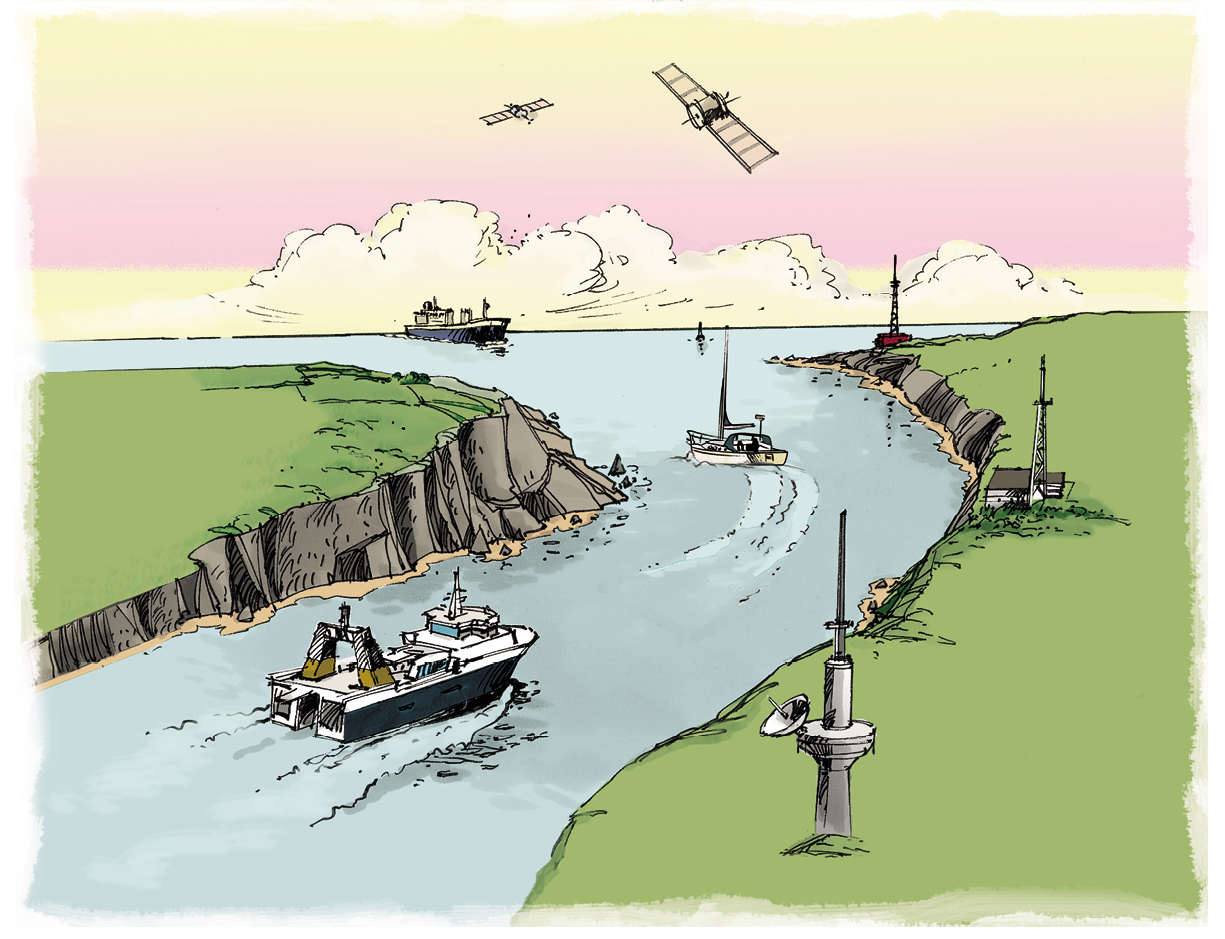
SIGNALING
Blasts on the air horn are for close range communication, not expressing your annoyance. Unfortunately, most boaters don’t know the standard signals. The two most essential signals to commit to memory are collision risk (five short blasts) and a warning signal when there is limited visibility around an obstruction (one prolonged blast).
The horn can also be useful for alerting an inattentive watch. Most commonly, I have used the horn to wake someone up when I feel sure they don’t see me (a boat with a deck-sweeping genoa, for example) or are not paying attention (a boat steering erratically). Making way near a blind exit at a marina or near buildings that block visibility ahead are other common situations that call for a warning signal.
VHF is acceptable for communicating with commercial shipping, but is not a substitute for following COLREGs and is not always useful for avoiding collisions. Language barriers are a common problem, the bridge crew can be task-saturated, and other ships in the area may not follow the conversation or agree. Automatic Identification System (AIS) and Digital Selective Calling (DSC) have made it easier to identify and contact unknown vessels, but a call on VHF 13 (used for commercial ship-to-ship maneuvering) or VHF 16 is still the most common means of hailing another ship in your vicinity.

Rule to Remember, #34: When vessels are in sight of one another, a power-driven vessel under way, when maneuvering as authorized or required by these rules, shall indicate that maneuver by the following signals on her whistle: one short blast to mean “I am altering course to starboard;” two short blasts to mean “I am altering my course to port;” three short blasts to mean “I am operating astern propulsion.”
WATCHKEEPING
Every close call I have ever had with another boat related to their failure to watch where they were going. On one memorable occasion we were both reaching with the chute up, with a closing speed of better than 20 knots. I indicated to my partner that although we were privileged in relation to the 60-foot yacht whose path we were crossing, there was clearly no one on deck or on watch. We blew the horn, jibed away, and only after we completed our turn did a startled-looking head appear from below. They were on autopilot with no watch.
Watchkeeping means keeping your eyes out of the cockpit. The instruments and chart plotter call for your attention, but keeping a visual lookout is primary, even with radar, even at night. The lookout requirement does not go away when you are drifting or anchored, and expires only when the boat is tied to a dock.

Rule to Remember, #5: Every vessel shall at all times maintain a proper look-out by looking and listening as well as by all available means appropriate to the prevailing circumstances and conditions so as to make a full appraisal of the situation and of the risk of collision.
KAYAKS AND ROW BOATS
In summer I find myself surrounded by a flock of people in rental kayaks who have no awareness of navigation rules. They believe the harbor is a park, and they don’t understand the traffic patterns or the maneuvering requirements of the boats that come and go.

The COLREGs are mute on the subject of human-powered craft (other than lighting requirements), but the Coast Guard addresses this on the Frequently Asked Questions subsection of its Navigation Center website:
Although a vessel under oars may be lit as a sailing vessel, one should not infer that they are considered to be a sailing vessel for other Rules (i.e. Rule 9, 10, 12, 18 or 35). Ultimately, the issue of whether a vessel under oars is the give-way or stand-on vessel would depend upon what would be required by the ordinary practice of seamen, or by the special circumstances of that situation (Rule 2) and the notion that they are less able to maneuver than most other vessels.
The “ordinary practice of seaman” can be taken to mean common sense. But common sense always requires both knowledge and reflection. Some kayakers know the rules and respect the maneuvering needs of yachts. Some don’t. It is your job to avoid the latter folk regardless of whether they are abiding by the COLREGs.
Certain inland waters may have different rules for human-powered craft. The state of Minnesota and the city of Oceanside, CA, for instance, have local regulations that take opposing stances regarding the right of way of small craft.

HIGH SPEEDS AND ERRATIC COURSES
When something dumb is happening in front of you while driving on the interstate, you lift your foot off the gas to slow a little, while considering other options—including changing lanes. Most discussions in the COLREGs focus primarily on making course changes, but it also addresses safe speed. Speed control applies to sailing vessels as well, since you can ease sails in a second or furl a jib in a minute. Beating or reaching you can simply luff. Downwind you can steer dead downwind and stall the sails. Of course, these later actions could also be misinterpreted as course changes and lead to others to question your intentions. In short, consider all your options—including changing speed. Always try to make your intentions clear.
Keeping the boat oriented in the same direction (holding or keeping station) can be difficult when going slow. This is simple with twin screws or an outboard. In either case, it is useful to turn either bow or stern towards the wind or tide. Backing into the wind or current is often an effective way to hold station. For powered sailing monohulls, backing into the wind and prop walk are your friends. Consider this a skill set worth acquiring for close maneuvering in marinas.
Fast vessels often weave, making it impossible for the slower vessel to predict their course and decide to either give way or stand on. For example, in a typical situation, a kayaker in open water might be moving two or three times slower than the sailing yacht. The sailing yacht, if following the wind, is constantly changing course, so the kayaker might be unsure of the yacht’s true course. The practical solution is for the sailboat to give way to the kayak. However, don’t expect a fast-moving powerboat to give a sailboat the same consideration. In general, fast-moving powerboats are a hazard to be avoided when practical, regardless of what the rules say. Because the situation is unpredictable, any course changes should be made as early as practical and be obvious; things happen too fast at the last moment.
If a vessel is weaving, is it on a defined course? To apply the Rules, you must first know what the other vessel is doing, and if that is unclear, it’s a situation of special circumstances (Rule 2). This can include water-skiers, wind surfer, kiteboarders, personal watercraft, and all inattentive operators. If you are the water-skier or wind surfer, your variable course makes you give-way in virtually all circumstances, and that applies to your interactions with other people when you are tacking randomly across the bay. The rules have little tolerance for the boater who behaves erratically.
However, don’t dismiss a vessel’s course as erratic too quickly. The turn may be part of a maneuver to avoid a collision. When tacking, or hoisting or dousing sail, your course may appear erratic, so you must keep clear of all other vessels during these situations and not create a conflict by your actions.
It is common to approach a channel at an angle, and it’s often not clear to others whether you intend to cross or to turn into the channel. In a narrow channel, the boat in the channel is the stand-on vessel (Rule 9), but the moment it exits the channel, it can become the give-way vessel in a crossing situation. If you maintain course toward the vessel that has suddenly changed status upon leaving the channel, you risk confusing the other skipper (see “Potential Collision at Ship Channel Entrances”).
The takeaway is that places where a channel ends or begins are tricky because the applicable rule changes quickly and intentions of boats are not always clear. Adjust speed to avoid potential crossing situations that do not yet exist but may develop quickly.
Rule to Remember, #8(e): If necessary to avoid collision or allow more time to assess the situation, a vessel shall slacken her speed or take all way off by stopping or reversing her means of propulsion.
SPECIAL SITUATIONS
The overtaking vessel is never the stand-on vessel, not for sail, not for a boat that is restricted in its ability to maneuver, not for any vessel, except one that is not under command (which, by definition, has no control). Remember, if you cross another vessel more than 22.5 degrees aft of the beam, you are overtaking. Thus, passing in a narrow channel is generally bad and it is 100 percent your responsibility to keep clear, no matter how slow the boat in front of you is moving.
I’ve seen this one misinterpreted by hot shots who like to sail into their slips, claiming that they are under sail, and this gives them “rights.” Nope, not in narrow channels or when overtaking.
The Rules contain some common-sense requirement for smaller boats to keep clear when operating in large ship channels.
Rules to Remember: #9(b), #13, #18(d)(i): #9(b) a vessel of less than 20 meters in length or a sailing vessel shall not impede the passage of a vessel that can safely navigate only within a narrow channel or fairway.
13: Overtaking. (a) Notwithstanding anything contained in the Rules of Part B, Sections I and II, any vessel overtaking any other shall keep out of the way of the vessel being overtaken.
18(d)(i): Any vessel other than a vessel not under command or a vessel restricted in her ability to maneuver shall, if the circumstances of the case permit, avoid impeding the safe passage of a vessel constrained by her draft, exhibiting the signals in Rule 28.
THE ISSUE OF RAM
In general, this applies to ships that are limited in maneuverability by the work they are doing, such as laying cable or dredging, but can it also apply to fishing boats, or even a sailboat that is using a drogue or sea anchor in extreme weather? We have been advised it can. During my drogue testing (see “Using a Jordan Series Drogue for Steering,” PS August 2017), I began to wonder who would have right of way in such a situation. My boat was restricted in its ability to maneuver, or RAM; did this make me privileged over other vessels?
When you are dragging a drogue you are not claiming you have no ability to maneuver, only that this ability is restricted. In a severe storm, it may be a life-or-death decision to cut the drogue loose, and you may still not be able to maneuver with any accuracy.
The critical factor is that you must declare your RAM or NUC status with appropriate lights or day shapes. Unlike other status that may be visually obvious—sailing vessel or commercial fishing, for example—RAM and NUC conditions are generally not obvious and must be communicated. You are only RAM or NUC if you signal surrounding vessels that you are (see “RAM Lights for Sailboats,” PS June 2022.) The USCG has this to say about determining RAM: The determination of whether a vessel is restricted in their ability to maneuver is at the master’s discretion. Should a master consider their vessel restricted in their ability to maneuver, the vessel shall exhibit the lights or shapes as such (Rule 27) in accordance with the technical specifications (Annex I).
Rule to Remember #39 (f): (f) The term “vessel not under command” means a vessel which, through some exceptional circumstance, is unable to maneuver as required by these Rules. She is therefore (g) restricted in her ability to maneuver, which means a vessel, from the nature of her work, is restricted in her ability to maneuver as required by these Rules and is therefore unable to keep out of the way of another vessel.
DISTRESS SIGNALS
The various lights and shapes to indicate distress are clear (Rule 37), but two deserve some special mention in this age of electronic flares and signaling devices.
Flashing lights. In the US inland Rules (not international) a bright flashing light of 50–70 flashes per minute is considered a distress signal.
Electronic flares. (See “Distress Flares Go Electric,” PS June 2021). Approved as electronic visual distress signaling devices (eVDSD) in 2015, electronic “flares” signal SOS (… — …) according to one of two patterns. Whether you chose to use these to replace traditional pyrotechnic flares, or to add these to your signaling tool kit is up to you. Either way, you should learn to recognize the flashing pattern.
CONCLUSION
Unlike driving a car, where blame is often settled on one party, boating collisions virtually always result in shared responsibility. You could have done something differently. You could have turned earlier, in a different direction or simply slowed down. You could have signaled.
The COLREGs guide us toward predictable maneuvering between yachts traveling in straight lines, but when faced with awkward crossing, fishing boat that is drifting or trolling multiple lines, or a paddler that may or may not know the rules, you must combine your knowledge of the rules with attentiveness, patience, and courtesy.
REFERENCES
USCG NAVIGATION RULES www.navcen.uscg.gov/sites/default/files/pdf/navRules/navrules.pdf
STATUS OF HUMAN POWERED BOATS www.navcen.uscg.gov/navigation-rules-faqs#0.3_13
FISHING WITH TRAPS www.dco.uscg.mil/Portals/9/DCO%20Documents/5p/CG-5PC/CG-CVC/CVC3/publications/Safety_Digest-2008.pdf WORLD
SAILING RULES www.sailing.org/tools/documents/WorldSailingRRS20172020new-%5B24067%5D.pdf
The COLREGs do not deal directly with human powered vessels, and rules for small boats can vary depending on the jurisdiction. Compare the respect for paddle-power in Minnesota, where canoes have a long history, and in Oceanside, CA, where many small craft are banned from the harbor, and those allowed must give way.
Minnesota 6110.1200: A non-motorized watercraft has right-of-way over a motor-powered watercraft except when it is the overtaking watercraft. Motor-powered watercraft should always keep clear and pass astern of non-motorized watercraft.
Oceanside, CA. Sec. 29A.16.: . . . All human powered vessels authorized in the harbor pursuant to this subdivision (b) shall give way, yield the right of way
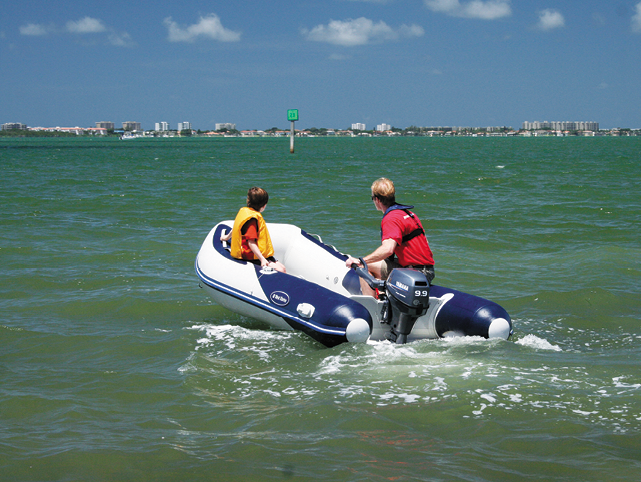
1. Adding an outboard changes rights of way rules for dinghies.

2. Fast-moving windsurfers and kiteboarders can present a navigation challenge. Some harbors restrict their use.
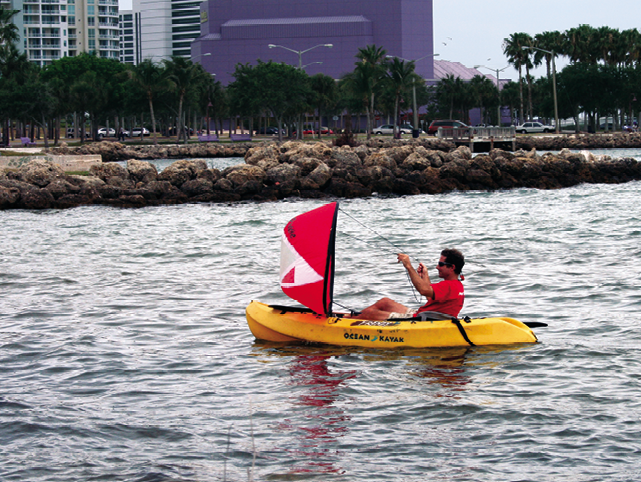
3. Kayak, or sailboat? Either way, we’d give this fellow a wide berth.
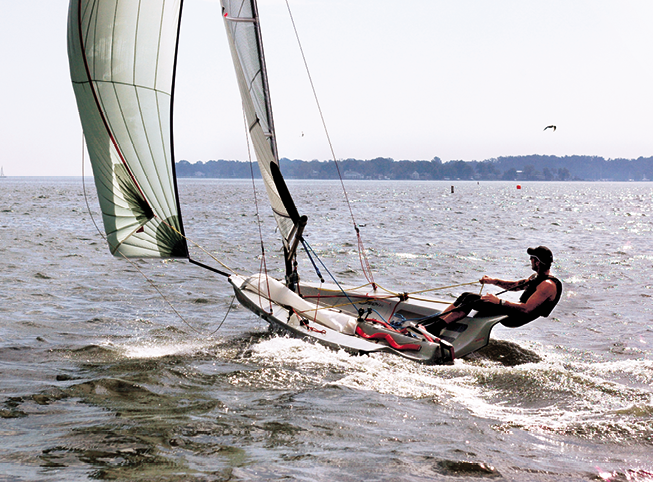
4. A prudent navigator will try to anticipate erratic steering from a
single-handed sport boat, especially one that is flying an asymmetrical sail.

As described in the example below (based on an actual collision), the entrance to marked ship channels can create a potential collision risk when a privileged deep draft vessel exits the channel. Once in deep open water, a deep draft ship loses its privileged status as a vessel constrained by draft. Should another boat be entering at the time of this transition, the question of right of way can be confusing.

Figure 1. The deep-draft outbound yacht Big Red (orange track) is navigating a narrow channel. The inbound boat Little Blue (blue track) will cross the channel. Because the Little Blue is on the starboard side of Big Red (which has just exited the narrow channel) it is stand-on, but Big Red, who was the stand-on boat just seconds before, may not have time to avoid Little Blue.
Despite having right of way in the immediate moment, Little Blue should wait, because it was the give-way vessel when avoidance maneuvers should have been made, well before the actual encounter.
In the trial resulting from the actual incident, the court divided responsibility between the two vessels, ruling that the outbound boat could have slowed when it observed the situation developing. However, the court found the inbound boat was primarily responsible because it should have waited for the outbound vessel to cross.

Most of us see ourselves as cruisers, not racers. For the most part, the racing rules are a logical extension of the COLREGs, but racing is all about passing, so there are differences. In principle, these rules only apply to meetings between sailboats in races (the COLREGs govern in all meetings with a boat not engaged in the same race), but except for Rules 11 and 12, they logically apply to all meetings. These rules can be helpful even to non-racers because they offer further insight into the COLREGs and the logic behind them. Sailboats are not always privileged, and your maneuvers can make you the burdened vessel.
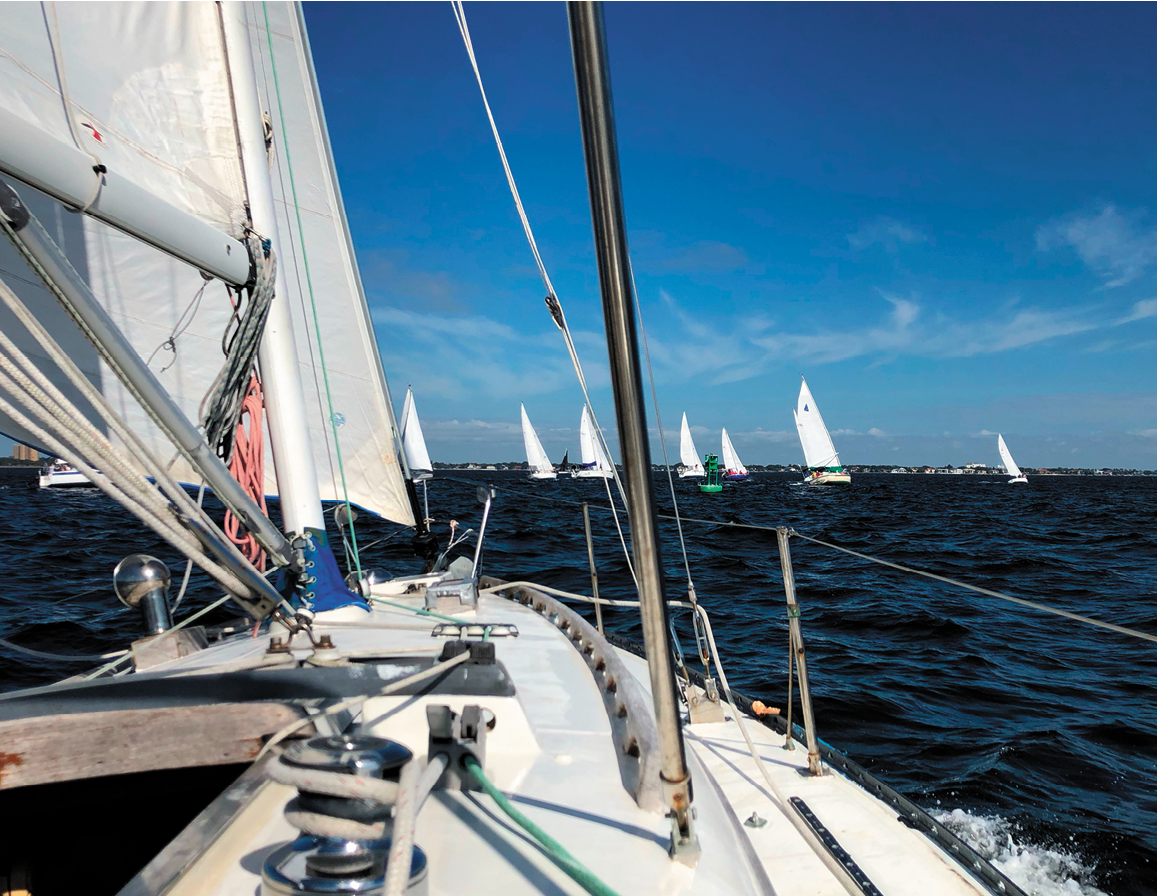
Rule 11 | Overlap. When Boats are on the Same Tack and Overlapped, a boat to windward shall keep clear of a leeward boat. Since racing is all about passing other boats, the rules depart from the COLREGs’ strict give-way rule (COLREGs Rule 13) for the overtaking boat. The conflict here is that the leeward boat may also be overtaking under the COLREGs (crossing from more than 22.5 degrees aft of the beam) which makes it burdened, and this rule supersedes all others in this case. Rules 12 and 17 (below) offer some clarification.
Rule 12 | On the Same Tack, Not Overlapped. When boats are on the same tack and not overlapped, a boat clear astern shall keep clear of a boat clear ahead, but only until an overlap is achieved.
Rule 17 | On the Same Tack; Proper Course. If a boat clear astern becomes overlapped within two of her hull lengths to leeward of a boat on the same tack, she shall not sail above her proper course while they remain on the same tack and overlapped within that distance, unless in doing so she promptly sails astern of the other boat. Note that “true course” can allow the leeward boat to force the windward boat to turn or tack away. This is definitely not behavior permitted under the COLREGs.
Rule 13 | Tacking. After a boat passes head to wind, she shall keep clear of other boats until she is on a close-hauled course. During that time, Rules 10, 11, and 12 do not apply. If two boats are subject to this Rule at the same time, the one to port or the one astern shall keep clear. The COLREGs takes a similar stance on tacking—while tacking you are the burdened vessel because you are not on any true course and the angle of your maneuver is not known. Any restriction in your ability to maneuver is your own doing, so don’t tack or jibe in close proximity to other boats.
Rule 15 | Acquiring Right of Way. When a boat acquires right of way, she shall initially give the other boat room to keep clear, unless she acquires right of way because of the other boat’s actions. Under COLREGs, channel ends are a common case; while in the channel a vessel is typically privileged, but when the vessel exits the channel a crossing situation can immediately make the same vessel burdened. It is the duty of the crossing vessel to give the other vessel room to keep clear.
Rule 16 | Changing Course. When a right-of-way boat changes course, she shall give the other boat room to keep clear. This is common sense, and not in conflict with the COLREGs. When you turn, a new situation exists and you are responsible for what happens during the change.










































Sometimes one has the engine running, but not in gear, in case of trouble while sailing. Is the boat then a sailing boat or a power boat ?
What you suggest is common near bridges, for example, where the wind can swirl unpredictably.
The machinery must be in use to be defined as a power-driven vessel.
The appearance of smoke or water spurting from a fitting could mean a generator is running. The presence of a sail does not mean it is a sailboat. This is why dayshapes are required, though seldom used by recreational boats.
[From COLREGS definitions]
(c) The term “sailing vessel” means any vessel under sail provided that
propelling machinery, if fitted, is not being used.